Activity Reports:Japanese Studies and Intellectual Exchange:"Fostering Peace through Cultural Initiatives: Perspectives from Japan & Germany" International Symposium Report
Japanese Studies and Intellectual Exchange
Europe, Middle East, Africa Section
(Ai Goto reporting)
On May 14 and 15, 2009 in Tokyo, the Japan Foundation co-hosted the symposium titled "Fostering Peace through Cultural Initiatives: Perspectives from Japan & Germany" with the Goethe-Institut of Germany and the Mainichi Newspapers (for the open symposium on May 15).
・Click here for the symposium outline
Overview
The symposium was planned as part of the ongoing attempt by the Japan Foundation to look into the challenges and opportunities of "Fostering Peace through Cultural Initiatives" together with cultural exchange organizations from overseas. Our partner this time was the Goethe-Institut, a German non-profit cultural institution. The event was consisted of two parts: the experts conference on the first day and the public forum on the following day.
Report 1: Conference of Experts on Thursday, May 14 (Sakura Hall, The Japan Foundation) 9:30a.m. - 5:00 p.m.
Following the opening remarks made by representatives of the two organizations from Japan and Germany, H.E. Mr. Hans-Joachim Daerr, German Ambassador to Japan, delivered an address welcoming the audience.
During the morning session, Ms. Hiroko Inoue (formative artist), Ms. Helena Waldmann (choreographer and stage director), Ms. Rita Sachse-Toussaint (Director of Goethe-Institut in Kabul), Mr. Yasuhiko Shirakata (ceramic artist), Mr. Yasunori Nagaoka (ceramic artist), and Mr. Uli Gaulke (film director) introduced their respective activities in the conflict areas.
At lunch, the participants listened to speeches by Mr. Ronald Grätz (Secretary General of the Institute for Foreign Relations in Stuttgart) and Mr. Kenjiro Monji (Director-General, Public Diplomacy Department, Ministry of Foreign Affairs, Japan).
Session 2, held in the afternoon, began with keynote speeches by Amb. Kazuo Ogoura (President, The Japan Foundation) and Dr. Hans-Georg Knopp (Secretary General of the Goethe-Institut). They were followed by a lively panel discussion on the role of cultural initiatives in fostering peace. The panelists included Mr. Grätz, Professor Kenichiro Hirano (Professor Emeritus at the University of Tokyo and Waseda University), Mr. Megumi Nishikawa (Expert Senior Writer, Mainichi Newspapers), and Professor Yasushi Watanabe (Keio University). Mr. Tsuyoshi Takahashi (Special Assistant to the President, The Japan Foundation) served as moderator.
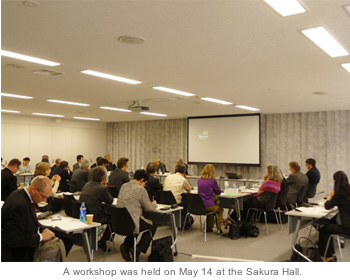
Report 2: Public Forum on Friday, May 15 (3:00 p.m. - 6:00 p.m.)
(Material distributed at the forum)
・Program (PDF/273KB)
・Introduction of the panelists (PDF/136KB)
Mr. Fumio Matsunaga (Deputy Director-General, Public Diplomacy Department, Ministry of Foreign Affairs, Japan) made a special remark before the keynote speeches were given.
[Keynote Speeches]
Amb. Kazuo Ogoura of the Japan Foundation and Dr. Hans-Georg Knopp of the Goethe-Institut gave keynote addresses. In his speech titled "On Cultural Initiatives for Fostering Peace, "Ogoura spoke on the initiative's conceptual framework, prerequisites, and practical challenges to be addressed. Dr. Knopp compared the history and environment of Japan and Germany and spoke of the challenges faced by the two nations with regard to cultural exchange under this context.
・Outline of Kazuo Ogoura's keynote speech (PDF/24KB)
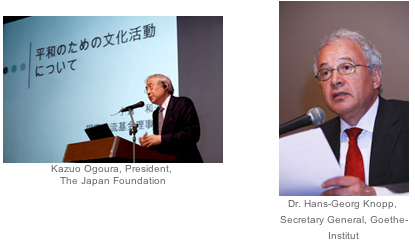
[Session 1] Presentation by artists and evaluation of their activities
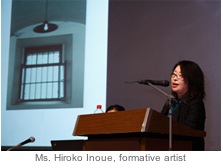 In Session 1, a formative artist Ms. Hiroko Inoue spoke on "Inside-Out: Realities and Expressions Found in Fieldworks from Around the World" and introduced art works in the motif of the psychiatric hospital which she presented in Germany, the United States and other countries. She presented works that focus on hidden conflicts and sources of anxiety.
In Session 1, a formative artist Ms. Hiroko Inoue spoke on "Inside-Out: Realities and Expressions Found in Fieldworks from Around the World" and introduced art works in the motif of the psychiatric hospital which she presented in Germany, the United States and other countries. She presented works that focus on hidden conflicts and sources of anxiety.
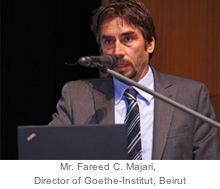 Mr. Fareed C. Majari, Director of Goethe-Institut in Beirut, gave a speech titled "When Everything Else Fails - The Role of the Arts in Conflict Resolutions - Cultural cooperation between Palestine, Israel and Lebanon." Based on his experience producing a festival in Lebanon, he cited cases in which even amid the rubble in conflict areas, people take an interest in the arts and find spiritual support in festivals.
Mr. Fareed C. Majari, Director of Goethe-Institut in Beirut, gave a speech titled "When Everything Else Fails - The Role of the Arts in Conflict Resolutions - Cultural cooperation between Palestine, Israel and Lebanon." Based on his experience producing a festival in Lebanon, he cited cases in which even amid the rubble in conflict areas, people take an interest in the arts and find spiritual support in festivals.
Then Mr. Yasuhiko Shirakata, a Tobe ceramic master of traditional craft, and Mr. Yasunori Nagaoka, also a ceramic artist, spoke on a project that was conducted with the Japan Foundation to support the potters of Istalif in Afghanistan. Mr. Shirakata gave a speech entitled, "Meeting with Istalif and Our Future," while Mr. Nagaoka spoke on "Guiding Istalif from Traditional Wood-fired Kiln to Gas-fired Kiln." Mr. Shirakata described how he was touched when, during his trip to Afghanistan as an advanced team member, a local potter said, "Yours are the hands of the potter." He suggested that the method of working-level exchange, which began during the program with Istalif village, be practiced in the second and third Istalif villages found around the world.
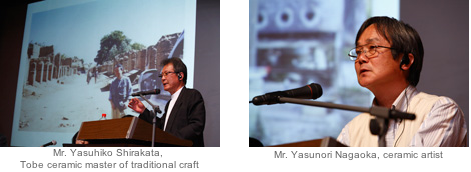
[Session 2]
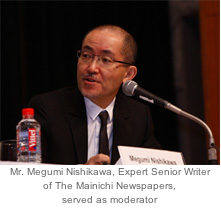 In Session 2, Mr. Megumi Nishikawa (Senior Editorial Staff Writer, The Mainichi Newspapers) served as the moderator of a panel discussion entitled "Fostering Peace through Cultural Initiatives." Participants discussed practical problems that arise when implementing cultural activities in conflict areas, and constraints against public cultural exchange organizations working in areas of securing risks.
In Session 2, Mr. Megumi Nishikawa (Senior Editorial Staff Writer, The Mainichi Newspapers) served as the moderator of a panel discussion entitled "Fostering Peace through Cultural Initiatives." Participants discussed practical problems that arise when implementing cultural activities in conflict areas, and constraints against public cultural exchange organizations working in areas of securing risks.
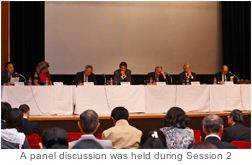 Professor Kenichiro Hirano (Professor Emeritus of the University of Tokyo and Waseda University) presented the four stages of conflict development based on the preliminary research report "Fostering Peace through Cultural Initiatives" compiled by the Aoyama Gakuin University Joint Research Institute for International Peace and Culture. The report was distributed at the venue as reference material. He introduced an overview of the possibility of intervention in each stage.
Professor Kenichiro Hirano (Professor Emeritus of the University of Tokyo and Waseda University) presented the four stages of conflict development based on the preliminary research report "Fostering Peace through Cultural Initiatives" compiled by the Aoyama Gakuin University Joint Research Institute for International Peace and Culture. The report was distributed at the venue as reference material. He introduced an overview of the possibility of intervention in each stage.
Dr. Hans-Georg Knopp (Secretary General, Goethe-Institut) and Mr. Fareed C. Majari (Director of Goethe-Institut, Beirut) expressed their wish for the media and politicians to better understand the relationship between culture and peace. Ms. Helena Waldmann (choreographer) spoke of the efforts of artists to express cultural barriers in a more visible form. Her opinion was based on her experience of presenting a theatrical performance about the burqa in Afghanistan.
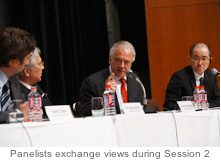 Professor Yasushi Watanabe (Keio University) pointed out that international benefits may exist in national interests and emphasized the danger of interpreting national interests in a narrow sense.
Professor Yasushi Watanabe (Keio University) pointed out that international benefits may exist in national interests and emphasized the danger of interpreting national interests in a narrow sense.
In conclusion, Mr. Nishikawa emphasized that new waves of arts and culture are born everyday and thus the media and cultural organizations must keep abreast of such trends.
Comments from the audience
Of approximately 100 audience members, 26 responded to the questionnaire. As to why they had taken part in the event, 25% cited that they "had an interest in the theme of peace and culture," followed by 10% who mentioned "peace-building and culture." As for the satisfaction rating, over 80% of the respondents replied that they were "very satisfied" (58%) or "somewhat satisfied" (29%). Some of the positive comments included, "I was learned about specific examples," "The panel discussion was thought-provoking," "We could hear from people who were actually involved in the projects," "I was impressed by the way Japan and Germany take the initiative to appeal to the international community." Meanwhile, most of those who were "somewhat dissatisfied" commented about the time and wrote, "The content is suitable for four hours. More time should have been allocated" and "Allocation of time was not clear."
Conclusion
While this preparatory stage of collaborative efforts based on discussion and analysis on past cases of the Japan Foundation and the Goethe-Institut has come to an end, the two organizations are going to study the feasibility of the specific Japan-Germany joint cultural projects proposed during the symposium.
Thank you very much all for taking part in the symposium.
*Photos taken by Atsuko Takagi on May 15
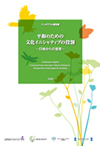 *A report of this conference "Fostering Peace through Cultural Initiatives: Perspectives from Japan & Germany" is published. Fore more information, click here.
*A report of this conference "Fostering Peace through Cultural Initiatives: Perspectives from Japan & Germany" is published. Fore more information, click here.
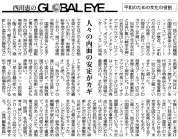 *A column introducing the symposium was published on Page 9 of the morning edition of the Mainichi Shimbun on Saturday, May 30 in "Nishikawa Megumi no Global Eye (Megumi Nishikawa's Global Eye)."
*A column introducing the symposium was published on Page 9 of the morning edition of the Mainichi Shimbun on Saturday, May 30 in "Nishikawa Megumi no Global Eye (Megumi Nishikawa's Global Eye)."
>>Click here to download PDF [345KB] (In Japanese)
Related Articles
Keywords
- International Conference
- Peacebuilding
- Japanese Studies
- Japan
- Germany
- Afghanistan
- Israel
- Lebanon
- Goethe-Institut
- Mainichi Newspapers
- Tokyo
- Hans-Joachim Daerr
- Hiroko Inoue
- Helena Waldmann
- Rita Sachse-Toussaint
- Yasuhiko Shirakata
- Yasunori Nagaoka
- Uli Gaulke
- Ronald Grätz
- Kenjiro Monji
- Kazuo Ogoura
- Hans-Georg Knopp
- Kenichiro Hirano
- Megumi Nishikawa
- Yasushi Watanabe
- Tsuyoshi Takahashi
- Fareed C. Majari
Back Issues
- 2025.9.30 The 51st Japan Found…
- 2025.9.30 The Japan Foundation…
- 2025.9.30 Bringing the World C…
- 2025.9.30 The 51st (2024) Japa…
- 2025.9.30 Japan Foundation Pri…
- 2024.5.24 The 50th Japan Found…
- 2024.3. 4 Movie Theaters aroun…
- 2023.4.10 The 49th Japan Found…
- 2023.3.28 JF's Initiatives for…
- 2023.1.27 Living Together with…

